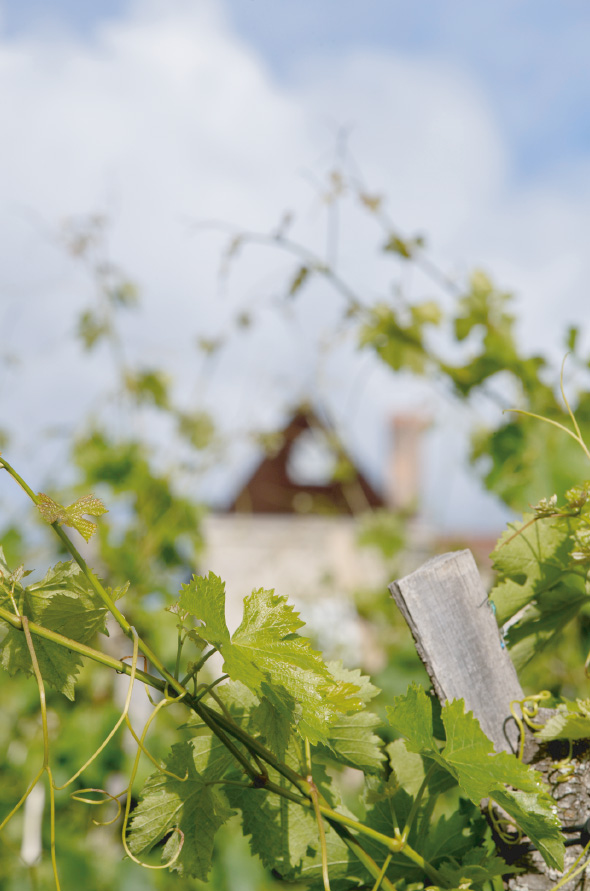Viti-
culture
Sustainable Viticulture
Agroforestry and Permaculture
Château Le Devay is first and foremost the home of the Fournet family. The choice of biodynamics was made from the very first spade strokes. Respect for nature and living things seemed obvious to preserve the harmony and tranquility of the place—a property set apart from the city, accessed by a small, peaceful road dotted with a few dwellings, 5 kilometers from Vienne.

The Choice of Plant Material
A Crucial Step
Concurrently, the Fournets contacted various nurserymen to initiate plantings in 2015, including Jean-Claude Lapierre in Savoie and Lilian Bérillon in Vaucluse. Diversity of plants and rootstocks (Riparia and 3039), and the quality of selections were thus prioritized, favoring massal selections (90% of the estate). The Fournets developed their collaboration with Christophe Raucaz and Jean-Claude Lapierre of VitiSavoie, nurserymen based in Verrens Arvey, Savoie, one of the few nurseries capable of supplying custom-made vines of such quality. They established a private “Château Le Devay” nursery to select and develop the best plant material and replant it on the estate. “We must reconcile several approaches to promote genetic diversity. Just as we wish to mix plant species, we also favor varied origins for our plants. The more varied, the more complex!” Advised by Pierre-Jean Villa, the Fournets began their plantings following lunar cycles; previously, the selected plots were worked and sown with green manures to welcome the young plants. The results were immediate, with a success rate of over 99% for establishment (an exceptionally high rate) and absolutely perfect vegetative development.
The Beginning of the Adventure
Enlisting the Best
As a rational and organized scientist, Jean-Charles Fournet did not wish to do things by halves. With his wife Florence, they chose the most arduous yet most exciting path: gentle viticulture, respectful of living things. This was an important choice from the outset, combining permaculture, agroforestry, and biodynamics. On the advice of winemaker friends, they called upon Claude and Lydia Bourguignon, eager to learn the perspective of these world-renowned soil microbiologists. A visual analysis of the land around the property already confirmed the presence of mica schist and perfect exposure. The Bourguignons identified 5.5 hectares of land ideal for planting Rhône grape varieties. Gigantic clearing works were then undertaken.


Field Grafting
An Ancestral Technique Revived
The encounter with Lilian Bérillon proved to be a revelation. A planting of 11,000 Riparia rootstocks was carried out in 2017 with a view to grafting in 2019 using massal selections of Roussanne and Syrah. They also enlisted the advice and expertise of Marc Birebent, from Worldwide Vineyards, who grafted the rooted cuttings using T-bud and chip-bud techniques, two ancestral grafting methods guaranteeing the best results. Marc Birebent’s teams visit in June during the sap rise; this long and demanding process spans 5 years, depending on the development of the rooted cuttings, as they can only be grafted once their trunk diameter exceeds 2 cm.

Sustainable Viticulture
The Choice for Life
Guided by their readings and the recommendations of their now fellow winemakers, Jean-Charles and Florence set high standards and envision the best for their vineyard. From the choice of rootstocks to the variety of grapes, everything is conceived with the idea of doing the best possible and as naturally as possible. The land is entirely worked by hand, with a winch, a
micro-crawler, and by horse. There is no shortage of tasks: sap-flow-respecting pruning, training on stakes, no hedging is practiced to allow the plant to complete its vegetative cycle, winding, braiding, cover cropping, mulching… Herbal teas, plant decoctions, and dynamizations are used throughout the plant’s vegetative cycle, respecting the lunar calendar, performed only according to needs and individualized for each plot.
Non-Mutilating Pruning Respectful of Sap Flow
A Herculean Task!
“Sap-flow” pruning, or non-mutilating pruning, allows for much better sap circulation and, above all, preserves the longevity of the vine stock. Formerly practiced, it was abandoned in favor of current pruning techniques, even though it appears to be one of the main solutions for the sustainability of plants and their preservation from diseases such as esca. Why, then, doesn’t everyone prune according to this method? Simply because it is restrictive, difficult to implement, and above all, requires much more time, once precise training has been provided to each pruner: this pruning indeed requires 130 hours of work per hectare, which is double that of “classic” pruning!
Biodiversity and Agroforestry
A Preserved Place
The viticultural endeavor is coupled with a desire to revive the estate’s original purpose through polyculture. A cider production project is also underway, initiated in 2019. In the near future, cows, sheep, and chickens are expected to join the estate. All other parts of the property, including embankments and fallow land, are thus enhanced with melliferous cover crops, allowing fauna and flora to find a suitable habitat. Nearly 1,500 meters of melliferous hedges and windbreaks are also replanted around the plots. On the periphery of the plots and within their heart, strips are left free, reserved for the planting of fruit trees of local and ancient varieties, in collaboration with Christophe Delay’s organic nursery in Estrablin (apricot trees, vineyard peach trees, almond trees, pear trees, apple trees), always according to the principles of agroforestry.

